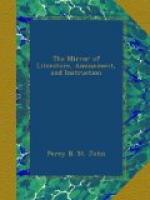Blackwood’s Magazine.
* * * * *
NOTES OF A READER
DUELLING.
Two French officers resident at Kermanshaw, lately quarrelled; a challenge ensued; but a reconciliation was effected; when the incident drew forth the following natural and affecting remark from a native:—“How foolish it is for a man who wishes to kill his enemy, to expose his own life, when he can accomplish his purpose with so much greater safety, by shooting at him from behind a rock.”
* * * * *
SPINNING VIRTUE.
A young preacher, who chose to enlarge to a country congregation on the beauty of virtue, was surprised to be informed of an old woman, who expressed herself highly pleased with his sermon, that her daughter was the most virtuous woman in the parish, for “that week she had spun sax spyndles of yarn.”—Sir W. Scott.
* * * * *
AT LINCOLN
There is a beautiful painted window, which was made by an apprentice, out of the pieces of glass which had been rejected by his master. It is so far superior to every other in the church, that, according to the tradition, the vanquished artist killed himself from mortification.
* * * * *
A great lawyer in the sister kingdom, when asked by the viceroy, what Captain Keppel meant by his “Personal Travels in India, &c.” replied, that lawyers were wont to use this word in contradistinction to “Real.”
* * * * *
It is said that the intestines of the Carolina parrot are an instantaneous poison to cats.
* * * * *
CHINESE DUNNING.
When a debtor refuses payment in China, the creditor, as a last resource, threatens to carry off the door of his house on the first day of the year. This is accounted the greatest misfortune that could happen, as in that case there would be no obstruction to the entrance of evil genii. To avoid this consummation, a debtor not unfrequently sets fire to his house on the last night of the year.
* * * * *
During the times of Catholicism in Scotland, Fishing was prohibited from the Sabbath after vespers, till Monday after sunrise. This was termed Setterday’s Slopp.
* * * * *
THE TOWER OF BABEL,
says a recent traveller in the east, now presents the appearance of a large mound or hill, with a castle on the top, in mounting to which, the traveller now and then discovers, through the light sandy soil, that he is treading on a vast heap of bricks. The total circumference of the ruin is 2,286 feet, though the building itself was only 2,000, allowing 500 to the stadia, which Herodotus assigns as the side of its square. The elevation of the west side is 198 feet. What seems to be a castle at a distance, when examined, proves to be a solid mass of kiln-burnt bricks, 37 feet high, and 28 broad.




